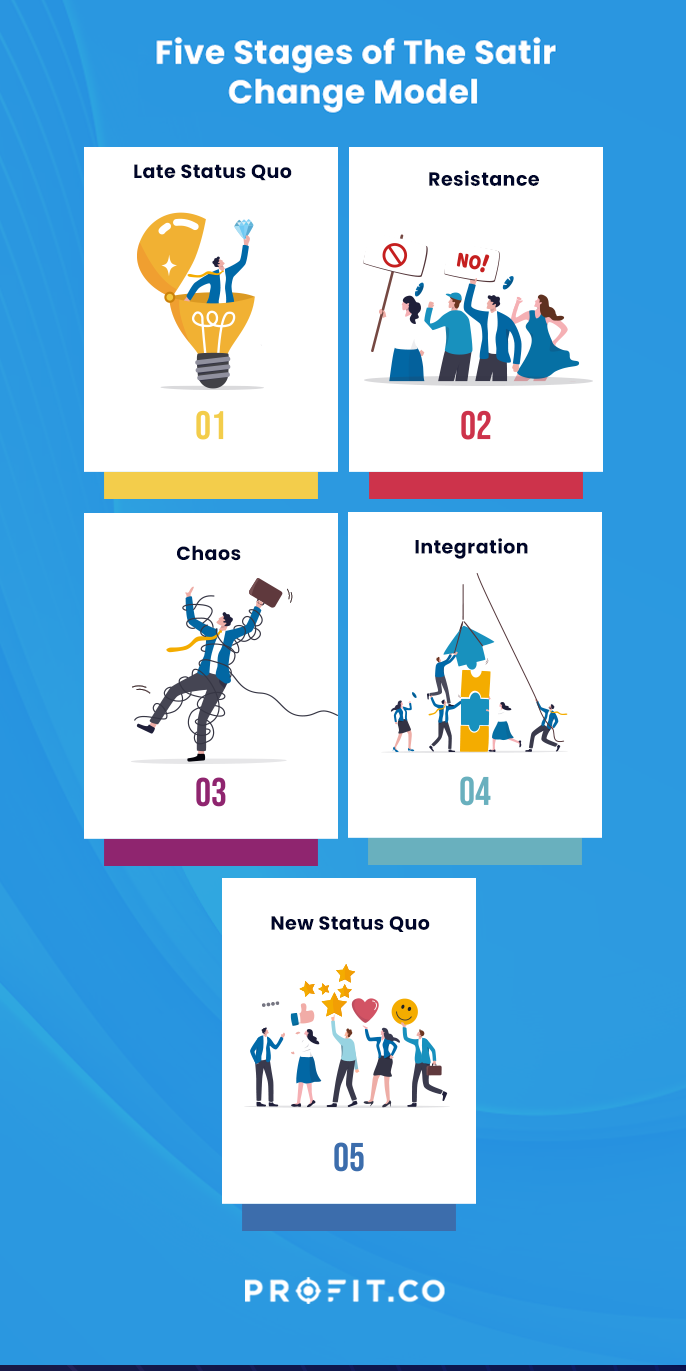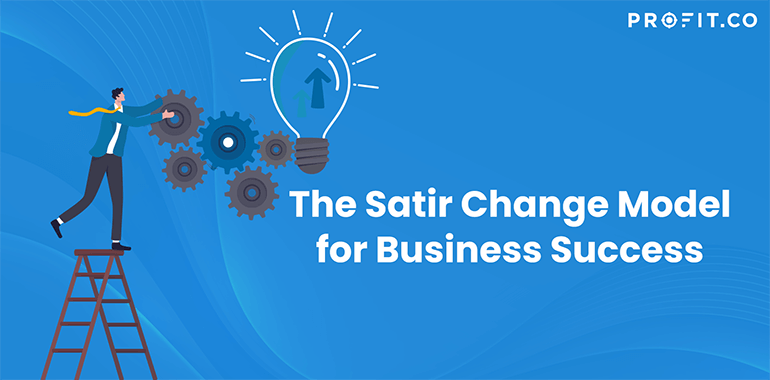Virginia Satir formulated and established the Satir Change Model, initially intended for family therapy. Satir created the model as a psychological tool developed through clinical studies. It illustrates how individuals cope with changes in their lives and relationship.
However, because it relates to human behavior and is backed by clinical studies, it grew in popularity among change management and organizational gurus. Throughout the 1990s and the 2000s, the Satir Change Model has been recognized as one of the most effective organizational change models globally.
Let’s dive into the Satir Change Model and learn how it can help your team implement effective organizational change and succeed.
Five Stages of the Satir Change Model
The Satir Change Model has five steps or stages individuals and organizations go through when making meaningful and lasting changes. The five stages are:
- Late Status Quo
- Resistance
- Chaos
- Integration
- New Status Quo

Stage 1: Late status Quo
It is where all things will start. Any organizational change will begin in its status quo or how things are normally done. According to Satir, this is a predictable and relatively safe environment for the members because this is how they have gotten used to doing things. It is a breeding ground of fixed ideas, familiarity, and routine.
However, it is also in this stage that organizational performances usually plateau. Since expectations are already set, motivation flatlines.
The leader will disrupt this status quo and introduce change in this stage. This might not be easy, but the organizational leader must first set the tone of change to be effective. This can be done by encouraging people to try new things, asking them to imagine how to improve their current processes, and asking people to be open to new ideas that come their way.
Ready to take your business to the next level?
Stage 2: Resistance
No matter how much planning to introduce change, it will almost always be met with some resistance. Because the organization’s usual flow and familiarity are disrupted, people are forced to work outside their comfort zones. Anyone forced to work out of their comfort zones is expected to feel disappointment and stress.
This is where organizational performance will decline. Because people spend their energy resisting the change, their productivity will begin to dip, and motivation will begin to go even below the late status quo level.
Leaders in this stage should acknowledge the members’ feelings because they are valid. In this phase, what leaders can do is give members time to let the ideas sink in and give them time to be upset about the upcoming change. Leaders can also provide the people with some form of optimism by expressing the benefits of the change in the long run.
Stage 3: Chaos
The next stage is chaos. Because of the introduced change and disrupted familiarity, people are trying to find their role in the new environment. This is the stage where members have already accepted that change is inevitable but are confused about how to proceed. As such, people in this stage may feel frustrated, angry, resentful, and stressed.
Organizational performance in this stage will be at its lowest. Motivation will be at an all-time low because of missing the familiarity of the old ways, unwillingness to embrace the new ways, and lack of knowledge on navigating the changes made efficiently.
What leaders can do in this confusing time is to remember that this stage is just temporary. They can help their members by building a safe and effective environment for feedback, asking and listening to their grievances, communicating the process clearly and effectively to the members, and giving them space to grow during their performance management appraisals.
I know people can change-right down to my bones, through every cell, in every fiber of my body-I now that people can change. It is just a question of when and in what context.
Stage 4: Integration
After the chaos, individuals will realize the change is not bad and start accepting it. In this phase, people begin to see the benefits of the change and start innovating ways to adapt. Usually, the difference between the chaos and integration phases is sparked by what Satir calls a “transformative idea” that helps people put their mindset out of the negative and into the positive.
In this phase, people start to find their unique roles in the new environment and figure out how to thrive. Because resistance and chaos have died down, organizational productivity increases. Motivation stems from seeing the change as a challenge they can overcome and excel in.
In this phase, leaders must continue to encourage their members. They should also offer emotional, motivational, or knowledge-based support to keep the momentum upwards. They can also promote collaboration and innovation to foster fresh ideas.
Stage 5: New status Quo
New status quo is the last step in the change journey in this model. The new status quo is where people have already adapted to the change and learned how to apply it effectively and efficiently. This is the part where they become better and better at what they do.
Because of the newfound skill, this is where organizational performance will peak. Motivation will also reach its highest not only because of the newly acquired skill but because members feel a sense of accomplishment that they can jump over the hurdles of change.
Leaders in this stage should know how to celebrate the wins by tracking the organization’s progress. Give recognition where recognition is due. Maintain open communication lines with the employee Feedback system to hear the remaining grievances and iron them out for optimum performance and member satisfaction.
The Satir Model and Organizational Change
The unique thing about this model is that a significant part considers resistance and chaos, the two main challenges of the transition process. Thus, this model will work best on unconventional and unpopular transitions anticipating resistance.
If you are an organization looking to make more controversial changes, this model will guide you through the expected resistance and chaos and bring you to the other side of the new status quo. Using OKR methodology to implement organizational change has been a popular global approach by silicon valley tech giants. Organizations and Individuals can use OKRs to Become better leaders. With the Satir change management model focusing on individual change and the OKR being a powerful change management tool, they can be used to get the desired effects.
FAQs
- What are the five stages of the Satir Change Model?
The five stages of the Satir Change Model are the late status quo, resistance, chaos, integration, and new status quo.
- How can leaders inspire change using the Satir Change Model?
The Satir Change Model ensures leaders that everything is temporary and that times of upheaval or intense emotions will pass. Leaders are encouraged to listen to feedback and provide a safe environment for employees to confide their concerns.
- What is unique about the Satir Change Model?
Due to the model highlighting the resistance and chaos stages, the Satir Change Model is equipped to handle more tumultuous changes.
Conclusion
Implementing the Satir Change Model will allow your organization to handle change and innovation effectively. Accounting for all the challenges and validating employees’ concerns will strengthen the support for change. Utilizing this model can help your business succeed in efficiency and internal communication. The Satir Change Model will provide a foundation for your team to evolve and thrive.

